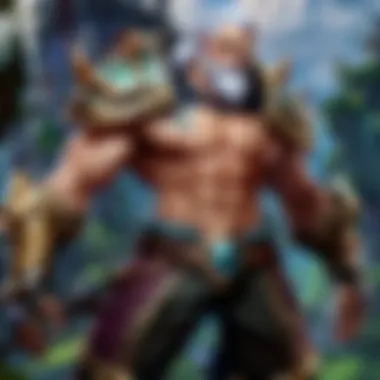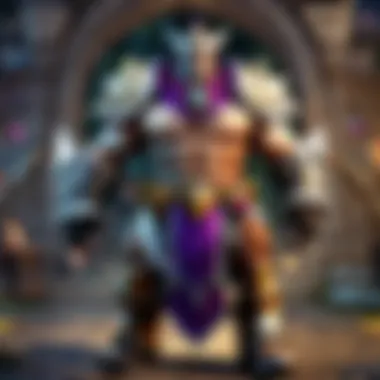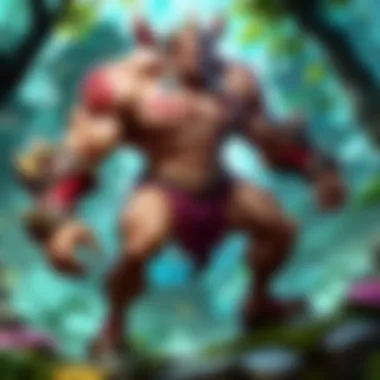Understanding the Complexities of Rolster in League of Legends


Intro
In the world of League of Legends, the concept of a rolster is central to understanding how teams function and compete in the intense environment of professional esports. A rolster refers not only to the collection of players within a team but also includes the strategic decisions that shape a team's configuration. Many factors influence this, from ensuring each position is effectively filled to responding to evolving player capabilities and the shifting landscape of the game. The implications of rolster management extend beyond team coherence; they affect game balance and the experience of players and fans alike.
To navigate this multifaceted subject, it is crucial to appreciate how team structure and individual choices intertwine with gameplay. Understanding the right mix of champions, builds, and tactics reflects a depth of knowledge that differentiates victory from defeat.
Champion Spotlights
New Champion Spotlight
Analyzing newly released champions provides valuable insight into their potential impact on competitive play. Each exemplifies unique mechanics and strengths that can shift team dynamics. Careful evaluation of a champion's abilities in context can help developers make informed decisions about lineup strategies.
Champion Builds and Strategies
Efficient champion builds are vital for optimizing a champion's effectiveness. Knowledge of itemization strengthens gameplay. For airy experiences, consider these considerations:
- Item Pathing: Selecting the right items based on the flow of the game can determine your champion's performance sphere.
- Runes and Summoner Spells: Tailoring these choices for specific match-ups enhances the game plan significantly. Understanding synergies can distinguish winning players from the rest.
- Individual Role Contribution: Encode each champion's performance into team objectives, ensuring a cohesive strategy tailored to capitalize on each player's strengths.
Gameplay Tips and Strategies
Early Game Tactics
Securing an advantage during the opening stages is fundamentally important for setting up a team for success.
- Map Awareness: Understanding lane placements and enemy intentions can foster beneficial trades and pressure.
- Objective Control: Timely invades and early wards will allow your team to influence early dragon or herald contests, ultimately leading to long-term rewards.
Team Fighting Strategies
Team fights take place often in League of Legends. Planning these encounters is integral to seizing control of the game. Key strategies include:
- Focus Fire: Selecting primary targets during skirmishes establishes dominance.
- Positioning: Ensuring support and backline priority creates safe conditions for damage dealers. Proper team positioning can tilt engagements favorably.
Patch Updates
Patch Notes Analysis
Regular updates to the game introduce changes that can alter the course of competitive play. Scrutinizing patch notes after each update allows players and teams to keep up with the meta.
Meta Shifts
Shift in meta games are often instigated by balance patches, cultivating new strategies and forcing adjustments etc. Understanding these adjustments becomes paramount. Familiarizing yourself with successful alternatives ensures resilience and adaptability.
Community News
Esports Coverage
The realm of esports escalates dynamic narratives surrounding competitive events and champion clashes among the best. Examining recent tournament coverage can foster deeper insights into strategic directions taken by winning teams.
Community Spotlight
The vibrant fanbase fuels pulsating energy within League of Legends. Recognizing community initiatives — be it charity work, fan gatherings, or interactive events — enhances the experience for viewers and gamers alike.
Bonus Content
Lore Exploration
Flushing out character backstories and regional lore creates a profound appreciation for the all infused drama in gameplay and world-building present within League of Legends. Understanding their origins allows players to connect more deeply with champions throughout the game.


Fan Creations
The creative influence from fans, comprising art, videos, and unique fan projects uplifts the community spirit surrounding League of Legends, enhancing gameplay experiences and forging communal bonds. Engaging with these endeavors can lead people to stronger participatory standing within the narrative detonating in the gaming arena.
Prolusion to Rolster
Roster management in League of Legends is a critical aspect of forming a successful team. A well-structured roster can profoundly influence a team's performance, affecting not only the players but also the entire gameplay experience. In an ever-evolving esports environment, decisions related to who plays where and when do not just impact results, but also shape the strategic direction of the team.
This section aims to shed light on the importance and complexities of rosters within the game. A clear understanding of the rolster allows teams and players to align their strengths with game strategies. Furthermore, this will articulate the core principles of effective team configuration and highlight the critical interplay between individual role expectations and collective outcomes.
Defining Rolster
In competitive gaming, particularly in League of Legends, a ‘rolster’ refers to the lineup of players assembled for a team. Each player is allocated a specific role such as top laner, midlaner, jungler, ADC, or support. This definition covers more than just player positions; it is also about how each member’s unique skills complement one another. The synchronization of roles determines the cohesion of the team’s gameplay and efficacy during matches.
(overworked % increases in recent tournaments have highlighted than some clenix organizations general issues to finding optimal competitions.) Effective rolster working is essential, giving partners access to skills tailored practiced well under match rules.
Historical Context
Understanding the historical evolution of rosters is vital when examining current practices in League of Legends. Originally, many teams were formed without considering the importance of player synergy or the strategic implications of roster changes. However, as interest in the competitive scene surged, teams began asigning specific players to focused roles to enhance performance.
The introduction of franchise leagues and structured tournaments has made rosters a subject of increasing relevance. Branding and marketing play a role in these contexts, as the composition of a professional lineup can dictate its popularity and financial support. Moreover, various cases exhibit that continuously improving roles lead larger in-growth— translating not only enhancements directly correlated with tendencies but similar encourages - regarding most fans involve their familiar given times.
This brief historical tone outlines not only how rosters came to exist in competitive play but highlights the sliding definitions — often morphing phases through both advantage concentrating metric positives fans expectations concerning teams approaches.
The Importance of Rolster Management
Effective roster management is a foundational element for success in League of Legends. It plays a critical role in determining the operational dynamics of a team. When a roster is well-structured, it not only maximizes individual player potentials but also enhances the overall synergy during gameplay. Key aspects of roster management contribute to team cohesion and flexible strategy adaptations, effecting outcomes in multiple matches.
Each choice in roster management carries weight. From player roles to champion selections, decisions cannot be made lightly. Mismatches in skills or playstyles might create friction that ultimately leads to subpar performance and unfulfilled expectations. Understanding this highlights the priority of crafting a formation that goes beyond mere talent. Here, interpersonal dynamics, communication styles, and behavioral attributes also factor significantly into creating an effective team.
"Roster decisions reflect a balance of skill and chemistry that is crucial in competitive gameplay."
Impact on Team Performance
The synergy between players directly correlates with their collective performance on the Rift. An optimized roster elevates performance in several ways:
- Diverse Skill Sets: An effective roster showcases a well-rounded blend of abilities. Each player has a specific role that allows strengths to amplify each other.
- Strategic Flexibility: Versatile players can fill various roles or adapt depending on the opponents. This adaptability establishes an unpredictable team, leaving rivals guessing.
- Momentum Building: When team dynamics are strong, players feel empowered. This leads to increased morale, which, in turn, enhances performance during critical moments.
Conversely, a disjointed roster can dampen growth and competitive spirit. Performance can stagnate due to a lack of harmony among players. Individual skills may falter when their focuses are misaligned.
Player Synergy
Player synergy emerges as an essential component in fleshing out superior roster efficacy. It refers to the degree to which players operate in unison, harmonizing their own strengths for the collective benefit of the team. High levels of synergy lead to an incredible flow during matches. Here are some additional focal points on player synergy:
- Communication: Clear dialogue among team members is vital. When players can articulate ideas effortlessly, their in-game strategies improve significantly.
- Confidence Building: Frequent successes encourage players. Sudden changes in a roster may lead to breakdowns in trust, thus impairing individual performance.
- Shared Goals: Roster members should synchronize their ambitions and mindsets. A polished roster holds standard expectations, driving competitive unity forward.
Mechanics of Roster Selection
Roster selection is a central component in the world of League of Legends. Understanding how to select a proper roster can significantly influence a team's competitiveness. The mechanics behind this process helps in identifying which players will perform best under certain conditions, as well as how they fit into the overall team strategy. With so many elements to consider, effective roster selection can actually set the stage for triumph or failure in esports.
Evaluating Player Skills
When evaluating player skills, teams need to adopt a comprehensive approach that includes multiple assessments. Traditional statistics like kills, deaths, and assists are important, but they do not tell the full story. Markov Blanket, for instance, can reveal deeper insights into player actions beyond mere numbers. Chad Shader is seen as another assets providing invaluable analysis.
Key elements to consider when assessing player skills include:
- Mechanical proficiency: This includes an understanding of champion abilities and execution.
- Game knowledge: A player's cognitive understanding of map dynamics, warding, and objectives.
- Communication: Successful teams require players who can articulate their micromanagement effectively even when the game is stressful.


Consistently monitoring players' progress over time allows teams to ensure they are choosing the best compatible players. The match setting and opponent team style should also influence player selection. Players are often categorized by positions such as Top, Mid, ADC, & Support, which also plays into their skill set.
Champion Proficiency
Champion proficiency serves as another fundamental factor in roster selection. Evaluating players for their ability to perform on various champions is critical for building a multifaceted team strategy.
A solid understanding of champion matchups helps players maneuver successfully in a game. Not positioning appropriately may lead to a loss, regardless of individual player sync. When examining champion proficiency, consider categorizing aspects like:
- Main champion pool: Each player should have a core group of champions they excel at.
- Flexibility: A player adept at multiple champions is crucial for adapting strategies mid-competition.
- Meta considerations: Depending on patches and updates, certain champions may ascend in viability.
A team's synergy heavily relies on champions’ interactions, leading to effective drafts during promotional periods. Draft strategies evolve rapidly, emphasizing the need for proficient players who are well-versed with a variety of champions ENDIA BLAME . Ultimately, prioritizing champion proficiency can lead to advantageous game potential.
The adept selection of players based on their skills and proficiency not only shapes overall gameplay but also ensures sustainable team success.
Strategic Implications of Roster Changes
Understanding roster changes in League of Legends is crucial for teams aiming to succeed within this highly competitive landscape. Roster changes affect not just the immediate dynamics of a team but also its long-term viability and those trained in the intricacies of southern calculators constantly measure such implications. Among these impacts, adaptability and player cohesion play a significant role in determining how effectively a team's strategy will translate to gameplay.
In-Season Adjustments
In-season adjustments pertain to the modifications made within a roster during the competition. Such changes can stem from various issues such as performance struggles, player availability, or enhancing tactical flexibility against opponent strategies. Certain factors make the timing and execution of these changes paramount.
During heavy tournament phases, teams often conduct evaluations that lead to player swaps. These swaps might occur to bolster team morale or to address gaps in gameplay, especially if specific matches expose weaknesses under high pressure. Some teams might replace underperforming members with fresh talent or even call up substitute players, enriching althetes' strategic variability. However, this approach also carries risks. Quick fixes can disrupt synergy and take time to cultivate anew.
- Timely Evaluations: Analyzing performance metrics and win rates helps in deciding when to make a change.
- Experimental Rotations: Systematically rotating players in a practice environment can clarify compatibility issues.
Roles within a Roster
The roles within a roster play a pivotal part in the overall functionality and success of a team in League of Legends. Understanding these roles is crucial not just for team compositions but for executing strategies throughout the game. The division of responsibilities among players creates a structured environment in which each member can excel in their specific area. Each role comes with distinct expectations, requiring tailored skills and approaches that reflect the game's demands. Recognizing the subtleties of these roles offers insights into effective team synergy and optimal performance.
Laner Responsibilities
Laning is often the first phase of any match where players start to build their own resources and establish their impact in the game. Top, mid, and bot-lane roles bring unique responsibilities, offering different ways to influence the game.
- Top Laner: Usually plays champions that can assume tank-like or bruiser roles. Their primary aim is to gain an advantage against the opposing laner, focusing on farm and experience to become a key power source later in the game.
- Mid Laner: Often play mages or assassins who can deal substantial damage at critical moments. The mid-laner should prioritize not just their own farm but also contribute to roaming and assisting other lanes, maximizing map pressure.
- Bot Laners: Involves both the ADC and support roles. The ADC must focus on last-hitting to ensure they scale into a late-game powerhouse. Their synergy with the support is paramount for controlling the laning phase and interacting positively with a variety of matchups.
Through their focus on wave management and skill execution, laners contribute fundamentally to the strategy and outcome of each match.
Jungler Dynamics
The jungler is a unique role that operates outside the traditional lanes. They have critical duties and responsibilities that can shape not just their own roster's dynamics but also the strategies against the opposing teams.
- Map Control: Junglers should always keep an eye on both lanes, making strategic ganks to give their laners a temporary advantage and control objectives, like dragons or Baron Nashor.
- Objective Focus: Securing objectives introduces a layer of team-wide advantages. Junglers need to be intuitive about when to pressure lanes, counter-gank, and take objective opportunities.
- Balancing Farming vs. Facilitating: Efficiently farming is important to keep their power levels up. However, junglers must continually evaluate the balance between their farming and their responsibility to provide assistance through early-game ambushes.
By expertly navigating the jungle, they guarantee essential contributions to both individual lane success and overall team strategy.
Support Functions
The support role, often underrated, holds immense value in terms of crowd control, vision, and survivability for the whole team. Ideally, support players devise methods to amplify team strengths while minimizing vulnerabilities.
- Vision Control: Placing wards in key positions provides vast amounts of information, impacting game sense significantly. The support's ability to secure and maintain vision can foster informed decision-making for the entire team.
- Peel and Engage: Support champions often have either toolbox capabilities. These functions can either protect damage dealers through crowd control or enable engagement by initiating team fights successfully.
- Resource Allocation: Depending on the team composition, support champions contribute to creating plays or capitalizing on enemy mistakes. Being mindful of how to allocate resources to the ADC allows for any spectrum of lane strategy—from playing defensively to pushing aggressively.
Their unique strategies can significantly influence the duration of individual engagements, the roles of carries, and the ultimate outcome of team clashes.
Effective management of roles defines team dynamics and synergy. Understanding individual responsibilities directly reflects the synergy and success of a roster in competition.
Community Reactions to Roster Changes


Community reactions to roster changes are critically important in the ecosystem of League of Legends. Every adjustment creates ripples that affect not only the teams but also the fans and the entire competitive environment. Dedicated viewers often passionately discuss the rationale behind such decisions, scrutinizing player performance and team synergy. The presence of vibrant online forums allows fans to engage, debate, and predict future outcomes, leading to a dynamic relationship between teams and their supporters.
Fan Expectations
Fan expectations often shape the perception of roster changes. When a well-known player leaves or a promising rookie joins, it can ignite conversations about potential growth or possible downfalls.
- Anticipation for Success: Fans wish for immediate results when new members are integrated into a team. They hope new mixes can revitalize struggling teams.
- Loyalty and Disappointment: Keeping original team members often creates emotional ties. Fans may react negatively when a favorite player is dismissed or traded.
- Hope for Skills Improvement: Viewers expect new players to bring abilities that can enhance a team's competitive edge, raising personal stakes in their performance.
These aspects mean that roster changes can be a double-edged sword, where excitement might accompany anxiety over the stability of a side.
Critiques and Praise
Tracking critiques and praise surrounding roster adjustments reveals how complex team dynamics are monitored closely by the community.
- Analyzing Performance: Fans will assess if newcomers perform as expected or fall flat. This binary judgment can sway public opinion significantly within days of a change.
- Informed Feedback: Insightfully, some community members analyze specific gameplay aspects, pinpointing what might improve or impede a team post-roster update.
- Balancing Responses: Over time, reactions may shift. Praise for a player's techniques might emerge after results improve, even if critics were initially harsh.
Ultimately, community reactions function not only as feedback for teams but also as potential influences in their decision-making processes. As established players and teams listen to audiences, whispers of critique or praise can affect the direction of future roster configurations.
“The voice of the community acts as a guiding force in unpredictable competitive landscapes.”
The depth and strength of an audience's reactions put it at the heart of roster conversations, signaling its importance for team psychology and fan loyalty.
Long-Term Impacts of Rolster Decisions
Long-term impacts of rolster decisions are vital in defining the success and resilience of any League of Legends team. These choices do not only affect team outcomes in the short term but also shape the future landscape of the roster, influencing brand value and player careers.
Franchise Sustainability
Franchise sustainability relates to the ability of an esports team to maintain and grow its platform over the years. A successful roster combines talented players with a strong synergy, a vital aspect when considering long-term effects. Decisions made during a roster’s formation can result in either prosper or underachievement.
- Building a Brand: When a team invests time in fostering a cohesion among members, its public image grows stronger. Fans become emotionally vested in the team’s journey.
- Marketability: A robust rolster attracts sponsorships. Advertisers seek out successful teams. This financial cycle can either thrive or crash based on initial roster choices.
- Competitive Edges: Teams that strategically select players can ensure their continuous presence at the forefront of competitions. Continuous evaluation of performances is essential for adapting over time.
Ultimately, the challenges faced by franchises stem from initial roster decisions that can last through seasons.
Player Development
Player development focuses on nurturing talent within a team. A well-structured rolster cultivates an environment where players evolve and refine their skills. This aspect serves to highlight the continuous journey of players and their potential to reach new levels of expertise.
- Mentorship Opportunities: Having experienced players within a team benefits younger or less experienced members. The sharing of knowledge and playing styles help hone skills.
- Adaptable Roles: An effective rolster permits flex in player roles, allowing team members to broaden their understanding of gameplay mechanics. This versatility strengthens teamwork.
- Emotional Stability: Developing players within a supportive environment motivates them. Strong support frmo teammates enables players to focus on improving rather than stress about metagaming decisions.
Maintaining stability within a franchise and fostering player growth can lead to sustained success in a competitive environment. Failure to do so may result in depleted potential and lost opportunities.
The Future of Rolster in League of Legends
The trajectory of rolster dynamics in League of Legends is poised for transformations that reflect broader trends within esports. To understand the importance of this future, one can assess factors that influence competitive play, organizational structures, and the player experience.
As teams navigate the iterative nature of the game, decisions related to the composition can significantly uplift or repel team cohesion. A well-crafted rolster not only considers individual skill but also the macro strategies that emerge from synergizing diverse playstyles. In light of recent evolutions, staying abreast of emerging trends and technological advancements will be crucial for sustained success and innovation within this landscape.
Emerging Trends
Emerging trends within rolster management in League of Legends illuminate how adaptation might dictate future frameworks. Some notable points to consider include:
- Flexibility in Roles: Teams are increasingly recognizing the necessity of adaptable players capable of navigating multiple roles. This flexibility promotes deeper strategic layers and enhances reactionary gameplay.
- Player Well-Being: The emphasis on mental health and work-life balance is more visible. Competitive environments are now prioritizing player satisfaction to maintain long-term talents.
- Diversity in Playstyles: Current compositions often herald a mixture of aggressive and cautious tactics. Successfully marrying these often disparate playstyles can yield unexpected advantages in-game.
Effective rolster management now requires more than merely acquiring skill. Character and adaptability have become focal points similarly relevant as the player's mechanical prowess.
Balancing these factors will ensure that organizations can react cogently, providing players the platform to flourish. Furthermore, a strategic focus on these trends can spell the difference between top-tier performance and unrewarded efforts.
Technological Advancements
Technological advancements play an instrumental role in shaping the future of rolster identity in League of Legends. The integration of analytical tools and improvement of communication channels are examples.
- Data Analytics: Informed decisions coming from in-depth match data analysis have empowered teams to understand not just their win ratios but the subtleties underlying player performances. Using tools like League of Legends’ match history and analysis services empowers teams to refine strategics on an ongoing basis.
- Real-Time Feedback systems: Integrating audio-visual communication enhancements permits players to consult strategy dynamically during matches. This mitigates miscommunication and augments decision-making processes in volatile situations.
- Fan Interactions Increased: Improving streaming services mends the gap between teams and their followers. Fans’ sentiments reflect back on rolsters and, in turn, influences player morale and roster quality.
The landscape within League of Legends continually evolves. It is incumbent upon both players and organizations to embrace change, adapt strategies consistent with technological progress, and comprehensively introspect player preferences. Enhanced understanding of rosters and the conceiving environment they dwell in will certainly dictate future outcomes.







